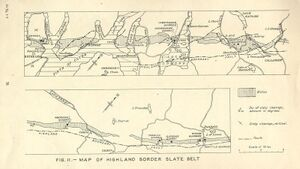Luss slate quarries, Highland Border slate belt, Scotland
| From: Richey, J.E. and Anderson, J.G.C. 1944. Scottish slates. Wartime pamphlet No. 40. London : Geological Survey of Great Britain. |
Luss


Maps. One inch to the mile (Geological: hand-coloured) Sheet 38
Six inches to the mile: Dumbarton, Sheet 10 S.E.
General Description
The Aberfoyle Slates occur in a belt about a mile wide on the west side of Loch Lomond at Luss. The belt includes several bands of grit, and is also complicated by faults, which run in a northerly direction and generally have the effect of shifting beds on the west side southwards relatively to those on the east side. Examples are:- (1) the fault crossing the western margin of the map (P519824) ; (2) the fault between Auchengaven Quarry and the old quarry immediately to the east: (3) the N. – S. fault crossing the centre of the map. This last fault shows an apparent shift to S. on its W. side, N. of the Luss Water; the contrary shift mapped S. of Purple Quarry cannot be relied upon owing to lack of exposure.
The slates were for long worked in a line of quarries locally known as The Trough which runs in a W.S.W. direction up the hillside north of Craignahullie. There appear to have been 5 or 6 benches, each 50 to 80 ft. high and from 30 to 40 yds. wide. Both grey-blue and greenish slates occur with cleavage dipping S. 30º E. at 60º to 70º. The bedding is difficult to make out, as the faces are very dirty. It is doubtful if The Trough would ever be worth reopening, as most of the workings are badly choked with debris. The uppermost opening is the freest from debris, and could perhaps be extended to W.S.W., but in this direction there is probably a fault about 100 yds. from the quarry edge. Moreover, the only access is by a steep and rough zig-zag track.
About 50 yds. S. of The Trough, nearer the main road, there is an old opening called the Level Quarry, which is largely choked with debris. Another opening, Creag na Bodach Quarry, about the same distance from the top of The Trough is in much the same condition.
At the Purple Quarry further south and lying about 450 yds. W.N.W. of Craignahullie conditions are perhaps more favourable. The face is up to 30 ft. high and shows about 40 ft. of good purplish slate, the cleavage of which dips 30º E. of S. at 70º. The bedding crosses the cleavage, producing striping, but its direction is difficult to make out. There are probably considerable reserves to the west, but the means of access are awkward.
Immediately west of Luss, near the north margin of the slate belt, there are other old quarries which can be regarded as worked out, since their expansion to the north is blocked by a road and to the south by the River Luss. There is another small opening south of the river, but very little rock can now be seen. Furthermore, the overburden to the south and west is very heavy.
Some 550 yds. west of the hotel at Luss the slate belt is crossed by the N. – S. fault which occurs west of The Trough. West of this fault there is a good outcrop of slate-rock which has been opened up in the Auchengaven Quarry. As this is the only opening from which production is now taking place in the Luss area, it is described in detail below.
Auchengaven Quarry
| Locality | 1,300 yds. W. by S. of the hotel at Luss and just south of tributary of Luss Water. |
| Access | 1,550 yds. by service road from main road S. of Luss. |
| Description of slate | Blue and grey somewhat rough; texture fine to medium. Pyrites very rare. Wastage about 88 per cent. of quarried stone. |
| Dips, with amounts | Cleavage-dip S. 30 E. at 70º. Bedding-dip W. at 70º at S.W. corner, W. at 40º further N.E. |
| Joints | Several strong joints dip N. 150º to 30º. Other joints occur, but show no regular orientation. |
Details of workings
The present working is a long narrow opening, with a face about 90 ft. high from the lowest point. There is a band of workable slate about 50 ft, thick, split roughly into two by a zone of quartz veins. Within the 50 ft. there are some six seams of higher quality material, but marketable slate can be obtained from most of the rock making up the width of the quarry. The seams of better slate are found to b lenticular both vertically and horizontally.
At the entrance to the quarry there is a fault, running N.N.E., which is also seen in the stream a short distance to N.N.E. The slates are much crushed along this fault and are shifted slightly to the south on the west side. They were formerly quarried to the east of this fault, which had to be broken through in order to open up the present working. The overburden in this working consists of boulder clay, which is up to 10 ft. thick in places but is locally absent.
Reserves
Widening of the quarry to N. is not possible owing to the stream. To S., after breaking through poor rock, further good seams might be encountered. There should be ample reserves along the strike to W.S.W., as there are not serious breaks showing in the stream for about 250 yds. where a large fault is reached which brings grits against the slates.